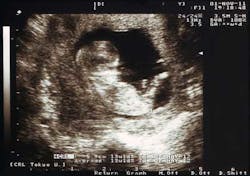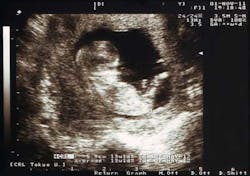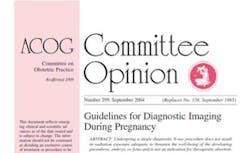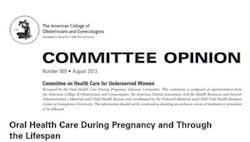Pregnancy myths and the dental office debunked
There has been much discussion on social media lately about pregnancy and care in the dental office, including the exposure of radiographs. There’s a lot of misinformation and advice given based on anecdotal experience or emotion. This article will focus on pregnancy and the dental office, specifically patients in the office. References are shared to provide further information.
We know that maternal illness during pregnancy is not unusual and sometimes necessitates radiographic imaging for proper diagnosis and treatment. While the mother-to-be may experience anxiety about potential harm to her fetus from radiation exposure, there is no need for concern in a dental office. The accepted cumulative dose of ionizing radiation during pregnancy is 5 rad, and no single diagnostic study, medical or dental, exceeds this maximum.(1) In fact, it would take 50,000 dental X-rays at 0.0001 rad to equal the 5 rad maximum.(2) For abdominal radiographs (multiple views), at 0.245 rads each, it would take 20 exposures to equal the 5 rad maximum. The most sensitive time period for central nervous system teratogenesis is between 10 and 17 weeks of gestation. Nonurgent radiographs should be avoided during this time, as unusual consequences of prenatal radiation exposure include a slight increase in the incidence of childhood leukemia and, possibly, a very small change in the frequency of genetic mutations.(1) However, diagnostic radiographs and treatment are not contraindicated.
The report stated that most obstetricians and dentists agree that pregnant women should receive dental services, but many dentists are concerned about the safety of dental procedures and medications during pregnancy.(6) Obstetricians are more at ease with their patients experiencing dental procedures during pregnancy but are less likely than dentists to recommend dental care to their patients.(6) Improved education regarding the significance of oral health, recognition of oral health problems, and information about procedure safety during pregnancy may make health-care providers more comfortable with evaluating oral health and more likely to address it with patients.(7)
Pregnancy is an opportune time to counsel patients. Advice should include limiting sugary foods and drinks, brushing teeth twice daily with a fluoridated toothpaste, interdental cleaning once daily, and visiting the dentist and/or dental hygienist twice a year or as indicated by their professional. Pregnant women with severe vomiting or gastric reflux can use an antacid or rinse with a teaspoon of baking soda in a cup of water after vomiting. Use of xylitol, chlorhexidine, and fluorides can help avoid damage to their teeth from acid.
Educating pregnant women about preventing and treating dental caries is critical. Most infants and young children acquire strep mutans bacteria from their mothers. Providing pregnant women with counseling to promote healthy oral health behaviors may reduce transmission of such bacteria from mothers to their infants and young children, thereby delaying or preventing the onset of caries.
Stay tuned for future articles about pregnant employees in the dental office, pregnancy and medications, and other issues relating to women’s wellness.
Maria Perno Goldie, RDH, MS, is the editorial director of RDH eVillage FOCUS.
References
1. Toppenberg KS, Miller DP. Safety of Radiographic Imaging during Pregnancy. Am Fam Physician. 1999 Apr 1; 59 (7):18131818.
2. National Council on Radiation Protection and Measurements. Medical radiation exposure of pregnant and potentially pregnant women. NCRP Report no. 54. Bethesda, Md.: The Council, 1977.
3. ACOG Committee Opinion No. 299. American College of Obstetricians and Gynecologists. Guidelines for diagnostic imaging during pregnancy. Obstet Gynecol 2004; 104:647–51. Reaffirmed in 2009.
4. Committee Opinion No. 569. American College of Obstetricians and Gynecologists. Oral health care during pregnancy and through the lifespan. Obstet Gynecol 2013; 122:417–22. http://www.acog.org/Resources_And_Publications/Committee_Opinions/Committee_on_Health_Care_for_Underserved_Women/Oral_Health_Care_During_Pregnancy_and_Through_the_Lifespan.
5. Offenbacher S, Beck JD, Jared HL, et al. Effects of periodontal therapy on rate of preterm delivery: a randomized controlled trial. Maternal Oral Therapy to Reduce Obstetric Risk (MOTOR) Investigators. Obstet Gynecol 2009; 114:551–9.
6. Strafford KE, Shellhaas C, Hade EM. Provider and patient perceptions about dental care during pregnancy. J Matern Fetal Neonatal Med 2008; 21:63–71.
7. Morgan MA, Crall J, Goldenberg RL, Schulkin J. Oral health during pregnancy. J Matern Fetal Neonatal Med 2009; 22:733–9.
Related Resources
• Association of State and Territorial Dental Directors. 2012. Perinatal Oral Health Policy Statement. Sparks, NV: Association of State and Territorial Dental Directors. http://www.astdd.org/docs/Perinatal_Oral_Health_Policy_Statement_July_26_2012.pdf.
• Association of State and Territorial Dental Directors, Best Practices Committee. 2012. Best Practice Approach: Perinatal Oral Health. Sparks, NV: Association of State and Territorial Dental Directors. http://www.astdd.org/perinatal-oral-health-introduction.
• Bertness J, Holt K, eds. 2012. Oral Health Care During Pregnancy: A Resource Guide. Washington, DC: National Maternal and Child Oral Health Resource Center. http://www.mchoralhealth.org/PDFs/OralHealthPregnancyResGuide.pdf.
• Holt K, Barzel R, Clark M. 2009. Two Healthy Smiles: Tips to Keep You and Your Baby Healthy (also in Spanish). Washington, DC: National Maternal and Child Oral Health Resource Center. http://www.mchoralhealth.org/PDFs/PregnancyBrochure.pdf.
• Insure Kids Now. 2013. Oral Health Education Materials. http://insurekidsnow.gov/professionals/dental/index.html.
• National Maternal and Child Oral Health Policy Center. 2012. Improving the Oral Health of Pregnant Women and Young Children: Opportunities for Policymakers. Washington, DC: National Maternal and Child Oral Health Policy Center. http://nmcohpc.net/2012/improving-oral-health-pregnant-women.
• National Maternal and Child Oral Health Resource Center. 2012. Resource Highlights: Focus on Pregnancy. Washington, DC: National Maternal and Child Oral Health Resource Center. http://www.mchoralhealth.org/highlights/pregperio.html.
Continuing Education
• DentaQuest Institute. 2013. DentaQuest Disease Management Series: Dental Caries Management–Perinatal (module 3). Westborough, MA: DentaQuest Institute. http://dentaquestinstitute.org/learn/online-learning-center/online-courseware/dentaquest-disease-management-series.
• Douglass AB, Maier R, Deutchman M, Douglass JM, Gonsalves W, Silk H, Tysinger JW, Wrightson AS. 2010. Smiles for Life: A National Oral Health Curriculum–Oral Health and the Pregnant Patient. Leawood, KS: Society of Teachers of Family Medicine. http://oralhealthpregnancy.talariainc.com/default.aspx?tut=560&pagekey=61366&s1=1721127.
• Quinonez RB, Boggess K. 2013. Prenatal Oral Health Program (pOHP). Chapel Hill, NC: University of North Carolina at Chapel Hill School of Dentistry, Department of Pediatric Dentistry and School of Medicine, Department of Obstetrics and Gynecology. http://www.prenataloralhealth.org/.
• Rizzolo D, Sedrak M, Boardman M, Chiodo TA. 2012. Oral Health During Pregnancy: What the Practicing PA Needs to Know. Journal of the American Academy of Physician Assistants 25 (12):54-57. http://journals.lww.com/jaapa/Fulltext/2012/12000/CME_Oral_health_during_pregnancy__What_the.11.aspx.




